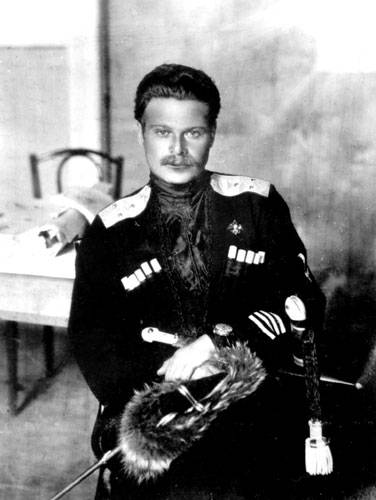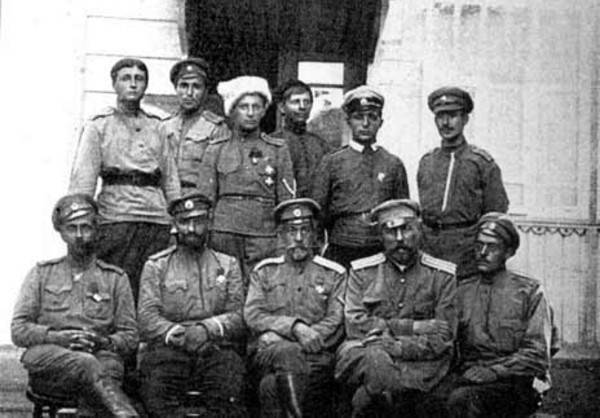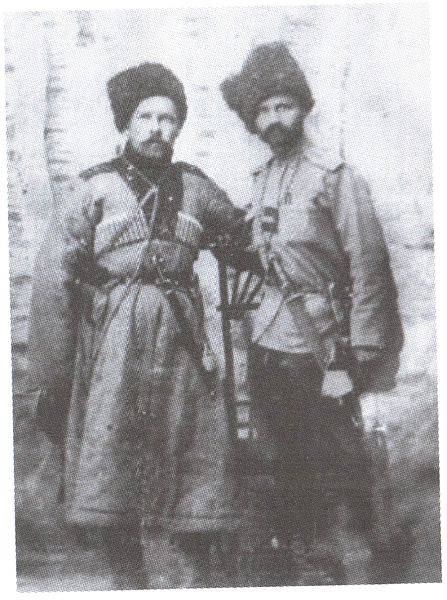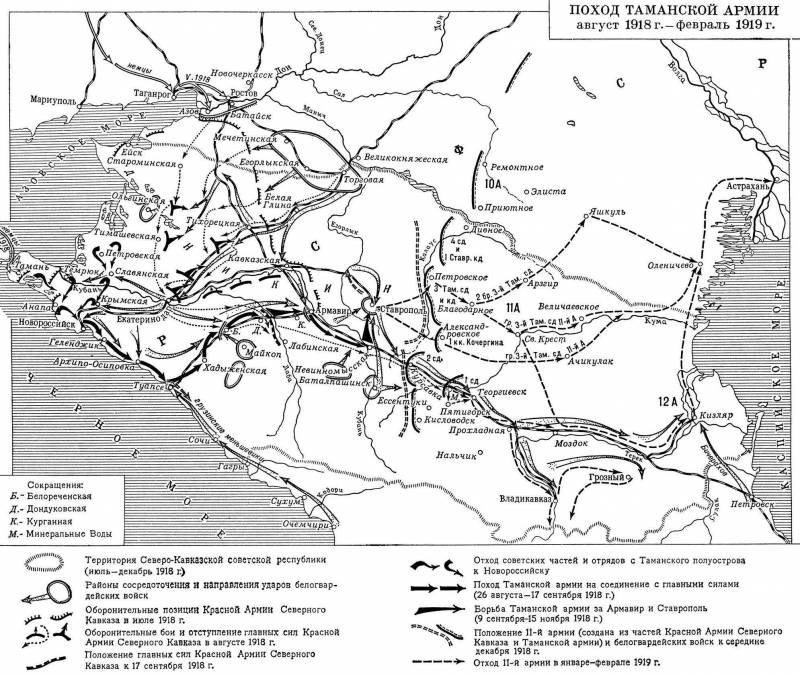Bloody battle for Yekaterinodar
Tikhoretsk battle
In the area of Belaya Glina - Novopokrovskaya, the Volunteer Army (YES) stood up to 13 in July of 1918, pulling up all its forces, providing private operations for the upcoming operation and its deployment. The White Guards rested, finally got the opportunity to sleep off, eat hot food and prepare for further battles. The next important stage of the Second Kuban campaign was the Tikhoretsk operation. The station Tikhoretskaya was an important transport hub on the way to Ekaterinodar. The capture of Tikhoretskaya white command attached paramount importance.
But before that, White decided to secure the left flank. To the south of volunteers, on the line Uspenskaya - Ilinskaya, there was a detachment of Dumenko and to the north of Stavropol in the area Privolnoe - Medvezhye several Stavropol detachments with a total population of several thousand people. Denikin 10 July, he ordered the commander of the 2-th division, General Borovsky, to smash the Reds from Medvezhy, Uspenskaya and Ilinskaya. The difficulty of the task was that the troops had to overcome 115 versts the way. It was possible to make such a rapid throw only with the help of the transfer of infantry on carts taken from the inhabitants of White Clay. July 11 Kornilovsky and Guerrilla regiments with the support of the Kuban Equestrian Regiment after a fierce battle captured the village Medvezhim. Particularly stubborn resistance was provided by companies of red sailors, whom the Kornilovites completely destroyed. Broken red fled towards Stavropol. July 12 division Borovskogo successfully attacked the village of Assumption, 13-Ilyinskaya.
Thus, Borovsky brilliantly coped with the task set for him. Raid Borovsky, according to Denikin, "flowed with speed, truly cinematic." The volunteer army now had the opportunity to concentrate all forces to deliver a strong blow to Tikhoretskaya.
July 13 (June 30 on Art. P.) 1918, Denikin spoke at Tikhoretskaya. Denikin planned the entourage of Tikhoretskaya: the 1 division was to attack the village from the north, the 2 division from the south-east, and the 3 division from the east. In Tikhoretskaya, a large grouping of red numbers up to 30 thousand people was concentrated. The commander-in-chief of the red troops of the North Caucasus, K. Kalnin, commanded the grouping. Early in the morning of July 14 (July 1 according to Art. S.) The Volunteer Army, which included the Soldiers (later - Samur) regiment formed from captured Red Army soldiers for the first time, launched an offensive. There was a fierce battle. Reds could not stand the onslaught and moved to the second line of defense. After such a stubborn fight, they were sure that there would be a pause, today Denikinians no longer attack. Meanwhile, the Kornilov regiment went to the rear and broke into Tikhoretskaya. Kalnin himself was nearly captured, and his chief of staff, military officer N. Balabin, fired a revolver, first at his wife, and then at himself. Left without command, under the threat of encirclement, the Reds fluttered and ran. The fight turned into a slaughter. White swiftly attacked, giving no mercy to anyone. Only a few echelons of red broke into Yekaterinodar, the rest were destroyed. The whole battlefield was littered with bodies. White captured unprecedented trophies - 3 armored trains, 50 guns, an airplane, a large number of machine guns, cars of rifles, ammunition and various military equipment.
Obviously, this failure of the Red Army was due not only to the military talents of the white commanders, but also to the serious mistakes of the red command. Kalnin finally lost the authority of the commander-in-chief, the sailors even attributed to him a "betrayal" of the revolution and tried to make a mob over him. The Central Election Commission of the Republic faced the issue of appointing a new commander in chief. S. Petrenko, who held the post of political commissar under I. L. Sorokin in those days, wrote: “Comrade. Kalnin, despite numerous reports from the front, remained motionless. In general, he did not seem to have issued a single worthy operational order, and he never went out of his car until he had to flee from Tikhoretskaya on foot after her occupation by the White Guards. Carelessness and colossal stubbornness - these are the factors that, united in the then Commander-in-Chief (Kalnina), cut us off from Tsaritsyn, and turned us over to the enemy Tikhoretskaya, i.e. the key of the whole Kuban ”.
The military commissariat announced a general mobilization to fight "the danger approaching from the enemies of the revolution in the North Caucasian republic". According to the text of the order, citizens, both passing and not passing military service, were called up from 20 to 43-year-old. The Soviet leadership decided to protect the Kuban to the last possible: the importance of Kuban bread for Central Russia, which was already experiencing acute food shortages, was very important.
Thus, white won an important victory. 30-thousand was actually destroyed. Kalnina group; volunteers received a solid rear and message Tikhoretskaya - Torgovaya, which allowed them to deploy troops in three important areas; All groups of the Red Army in the Kuban — Zapadnaya, Tamanskaya, Yekaterinodar, Armavir — were cut off from each other. The whites also captured huge trophies by their standards, which made it possible to financially ensure the growth of the army. In the moral sense, the battle of Tikhoretskaya strengthened self-reliance in volunteers and the whites thought that the Reds were already broken down and would not offer serious resistance. The authority of the DA and its commander consolidated, there was a continuous stream of volunteers from Novorossia and Little Russia. The Kuban Cossacks began to side with the whites (some mobilized by force). The number of army doubled - to 18 - 20 thousand bayonets and sabers. However, the reds had more serious resistance than the whites had supposed, YES lost more than a quarter of the original composition. At the same time, the best ideological fighters died.
Ekaterinodar operation
From Tikhoretskaya DA the offensive began in three directions. The 1 Division, together with the cavalry division and the Kuban Cossack brigade, advanced north-west, in the Sosyka-Kushchevka area, to the rear of the Sorokin army. The 2 Division moved south, towards the Caucasian railway junction, and the 3 Division moved west, towards Yekaterinodar, covering the Tikhoretsky railway junction. Each division independently carried out its task. The high combat qualities of the volunteers allowed Denikin to carry on military operations on a wide front and in different directions with the 20 of a thousand army. In addition, reds were demoralized by severe lesions.
July 16 army launched an offensive. Sorokin's troops numbered up to 30 thousand people, but after the fall of Tikhoretskaya she found herself in a difficult situation — she had to keep the front to the north (Germans and Donians) and to the south, having her own communications line under attack. Therefore, the onset of YES at first developed extremely successfully, the Denikins were rapidly advancing, almost without resistance. Sorokin’s army was leaving, “throwing its wagons, depots and loaded trains, trying to get out of the strategic environment and out of our strikes,” Denikin, who personally led the operation in the direction of Kushchyovka, recalled. Moving along the railroad to Rostov, the 1-division of July 18 with a battle occupied the station Sosyka. The 19 - July 21 units of Sorokin fought stubbornly defensive battles, holding back Denikin’s offensive and giving the opportunity to withdraw troops from the Bataysk and Kagalnitsky areas. Only by the evening of July 21, Kutepov defeated the enemy, retreating towards Kuschivka. In the morning of July 23, the columns of Kutepov and Pokrovsky entered Kuschyovka, and found that Sorokin had left the night westward along the Black Sea Railway to Timashevskaya from there.
Kutepov's division was transferred to Ekaterinodar direction. The pursuit of the main forces of Sorokin was entrusted to the Pokrovsky division (with part of the forces he also had to clear the Yeisk region from the Reds). 1-I horse General Erdelyi was supposed to move across the path to Sorokin between Starominskaya and Timashevskaya to strike him in the flank. However, Sorokin, throwing carts and trains, managed to escape from the strategic environment. He was helped by the fact that whites were in no hurry. Yeisk was busy on July 25. Pokrovsky, who loved to show off in front of the crowd, took the opportunity and turned off the road to personally visit this city. As a result, the division trampled on the spot for several days. Erdeli with 18 July remained in the Umanskaya area and either could not, or was afraid to strike Sorokin in the flank, leading small, protracted battles with his side barrier. On July 28, parts of Erdelyi occupied the villages of Pereyaslavskaya and Novokorsunskaya. But by this time Sorokin had already managed to concentrate troops in the Timashevskaya area.
The 2 Division of General Borovsky also brilliantly launched an offensive, smashing a group of Reds in the Caucasus region. Borovsky firmly established in the Caucasian railway junction, which separated Yekaterinodar, Stavropol and Armavir, opening volunteers freedom of action in all these areas and providing the main operational direction of the army (Yekaterinodar) from the south.
Meanwhile, the Kuban partisans Colonel A. G. Shkuro 21 July took Stavropol. Shkuro, who had at one time received a mandate to create Cossack detachments from the chief commander of the Red Avtonomov, allegedly with the aim of joint combat operations against the Germans and the "Cadets", used it at his own discretion, fighting for the time being against everyone, like a real free dad-ataman. Natural courage, great intelligence and common sense, a penchant for adventurism and non-standard solutions pushed him into the first row of the commanders of the Civil War. Shkuro organized a partisan detachment in the area of Kislovodsk, where at that time his family lived. In May-June, 1918, the detachment made raids on the Red occupied Stavropol, Yessentuki and Kislovodsk. As a result, Shkuro decided to join Denikinians.

Andrey G. Shkuro
This success prompted Borovsky to develop an offensive along the Vladikavkaz railway on Armavir. 27 July (14 tulle according to art. P.) The city was taken. Broken reds retreated to Maikop and Nevinnomysskaya. However, in Armavir, the White Guards, according to Denikin, were “too careless”. Borovsky underestimated the forces of the enemy. On July 30, the Reds, to whom significant reinforcements from Maikop approached, under the command of G.I. Zuev attacked Armavir from the west and threw volunteers to the Caucasus.
At first, the direction of the 3 Division of Drozdovskiy, which was active on the main one, was easy to cope with its task, overturning the enemy’s weak parts along the railroad, occupying the villages and drawing the Cossacks to participate in the struggle against the Bolsheviks. 22 July Drozdists took Art. Vyselki, 23-th - Korenovskaya, and July 26 - Plastunovskaya, located just 37 versts from Ekaterinodar. The Ekaterinodar operation entered its decisive phase, in directive No. 0503 of 13 (26) of July 1918, Denikin ordered his army “14 (27) of July to take possession of the mountains. Ekaterinodar. The headquarters of the army was dominated by the belief that the Bolsheviks were already broken and would not offer serious resistance near Yekaterinodar. To capture Yekaterinodar Denikin, a large part of the Volunteer Army was sent: the 1-division of Kazanovich and the 3-division of Drozdovsky advanced along the Tikhoretskaya line; 1-I horse division of General Erdeli - was preparing a strike on the city from the north; The 1-th Kuban division of General Pokrovsky (the brigade was reorganized into a division) advanced from the north to Timashevsk and further to the rear of the Ekaterinodar Red group. The 2 Division of General Borovsky was part of his forces to advance along the Caucasian railway line to ensure the main direction and distract the enemy. To support the rear of the Volunteer Army, the Plastun battalion with two guns was left in Korenovskaya. Denikin handed his farewell to each of the parts so that she “was the first to enter Ekaterinodar.” "This method of combat competition could not be more consistent with the general mood - everyone was torn to Ekaterinodar," A. I. Denikin himself described the situation.

The headquarters of the 1 Division of the Volunteer Army in the summer (July-August) 1918 of the year. Sit from left to right: Colonel N. A. Tretyakov, Commander of the 1 Brigade, Colonel A. P. Kutepov, Chief of the Division, Major General B. I. Kazanovich, Chief of Staff of the Division, Colonel K. I. Heideman
Battle for Korenovskaya. The fall of Ekaterinodar
White's victorious movement almost ended the Sorokin. He replenished the army, restored discipline with harsh measures, put up a barrier against Pokrovsky and unexpectedly launched an offensive. Rejecting Erdeli's cavalry, and, having passed the forced march of 40 versts, the red 28 of July captured Korenovskaya, thus being in the rear of YES. The divisions of Kazanovich and Drozdovsky were cut off from the division of Erdelyi and the army headquarters in Tikhoretskaya, where there were almost no troops. Kazanovich and Drozdovsky lost contact with the command. Tikhoretsky node was created an immediate threat. Denikin was forced to regroup his forces. The volunteer army was on the verge of defeat. A tough ten-day battle began for Korenovskaya. It was this battle, in fact, that decided the outcome of the Second Kuban campaign in favor of the whites.
Both sides fought extremely cruel, they did not take prisoners. Volunteers found the corpses of their comrades "lying undressed, disfigured, others with severed heads, others lying burned in the ashes of corn ...". The White Guards also did not spare the enemy. “Having arrived in their villages and towns,” General Ya. A. Slashchev wrote in his memoirs, “the whites found mountains of the corpses of their relatives and associates; from the survivors, they heard stories of perfect atrocities, husbands found their wives brutally murdered, with breasts carved, etc. Revenge began — it was difficult to get a prisoner to be questioned or a captured commissar to get information from him. If they were not killed during the seizure, they almost always ended up on the way to headquarters. There was no opportunity to hold the crowd, and the whites did no less than the red ones ... And there were many such atrocities on both sides — it was a product of madness and anarchy that always flares up in civil war. ” Earlier, the exodus of the peasant population began from a region seized by Denikin, telling the representatives of Soviet power about the horrors of the white terror with tears in their eyes. Between the declared liberation of Russia and the “liberation” of it in practice was a huge difference.
At the beginning of the battle, a conflict broke out between Kazanovich and Drozdovsky. Each divisional commander proposed his own plan of action. The situation was extremely dangerous, Drozdovsky was especially pessimistic, who suggested taking advantage of the darkness to retreat eastward and look for a roundabout connection with the commanding army or Borovsky division. According to Drozdovsky, "now there is nothing to think about any success - it is necessary to save parts from destruction." The white commander feared that his entire division would be in battle. Kazanovich protested: “Such a retreat would unleash the Bolsheviks' hands, they (take) Tikhoretskaya, break any connection between the separate parts of the army. The operation will be foiled. our retreat will lead to the defeat of the army in parts. On the other hand, it is impossible to imagine that the gene. Denikin remained inactive - obviously, he directs everything he managed to gather to the rear of the Bolsheviks standing against us. ” In the end, Kazanovich said that, due to the loss of communication with the army commander, he, as a senior officer on the basis of the field manual, took command of the group and ordered to resume the attack on Korenovskaya at dawn. Drozdovsky was forced to submit. July 30 whites repulsed Korenovskaya. True, the 1-I and 3-I division lost up to a third of its composition.
But already on August 1, Sorokin’s army is once again storming Korenovskaya, in which only parts of Drozdovsky remain. The Reds embarked on the complete encirclement of Korenovskaya. On the night of August 2, Drozdovsky was forced, leaving Korenovskaya, to break into Beysugskaya. On August 3, the Central Election Commission of the North Caucasian Republic, already noting the victory, appointed Sorokin commander-in-chief of the Red Army of the North Caucasus. In fact, there was no other candidate for the post of commander in chief, except Sorokin, for the red command. Other candidates — I. F. Fedko and D. P. Zhloby — found no support. Fedko, by all accounts, was an excellent “field commander”, but was not suitable for the role of commander in chief. The redneck, on instructions from the top commanders of the army, departed with a report to Tsaritsyn, asking the high command about the need for an offensive operation in the direction of the Merchant to connect with the North Caucasian grouping of the Red Army. In addition, the Goon did not want to serve under the leadership of Sorokin.
Sorokin, after successful battles for Korenovskaya, was very popular among the troops, among the Cossacks and restored the fighting spirit in the army. It is worth noting that Ivan Lukich Sorokin is a very tragic figure. In November 1918, a Kuban Cossack, a participant in World War II, a talented self-taught commander, was the victim of a mob. The very name of Sorokin, who was ultimately blamed for the defeat of the red troops in the North Caucasus, whom Sorokin commanded 3 of the month from July to October of 1918, that is, at the time when all defense collapsed because of errors former military-political leadership. Raising the "revolt" against the local Soviet authorities, Sorokin was killed and, already dead, accused of all mortal sins. The former head commander was ranked as "adventurers"; in the scientific literature, he was portrayed as a man of extraordinary power-hungry, cruel, and in general narrow-minded. Although the commander of the YES, Denikin, gave a high assessment to the actions of Sorokin during the battles for Yekaterinodar in the summer of 1918: “... the whole plan testifies to great courage and art. I do not know whose - Sorokin or his staff. But if in general the ideological leadership in strategy and tactics during the North Caucasian War belonged to Sorokin himself, then in the person of a medical assistant-nugget Soviet Russia lost a major commander ”.
On the whole, it is obvious that Sorokin was the most talented military leader and the most prominent figure in the Red Army of the North Caucasus. Some hated him, others admired him. For several days, YES was on the verge of defeat. By order of Denikin, Drozdovsky again tried to recapture Korenovskaya. Kazanovich meanwhile led persistent attacks of Berezansky and Zhuravki. Berezansky fell, but in Zhuravka the Reds stubbornly fought off. Only after transferring parts of Borovskiy to the battle area, the commander managed to reestablish contact with the severed divisions, and then overturn Sorokin's troops. On August 7, the volunteers occupied Korenovskaya and the Reds began a retreat along the whole front, partly on Timashevskaya, partly on Ekaterinodar.

Khorunzhiy I.L. Sorokin (right) on the Caucasian front
The White Army again seized the strategic initiative and was able to resume the attack on Ekaterinodar. The garrison of the city was about 10 thousand people, but it had low combat capability. The Red Commander, Sorokin, led his main forces away for Kuban and Laba, putting the defense of Yekaterinodar as a hopeless cause. At the same time, the Taman group of the Reds, left by Sorokin as a barrier against the Pokrovsky division, continued to defend themselves stubbornly, and only on August 14 was forced to leave Timashevskaya and begin to withdraw to Novorossiysk.
14 of August (1 of August according to Art. S.) The White Army surrounded the city with a tight ring from the north and east. On August 15, a white airplane flew over the city all day, scattering proclamations signed by Denikin with the proposal to surrender the city without a fight. The white general did not have the result of exhortations: the Reds resisted, but they quickly broke it. 16 of August (3 of August according to the art. P.), Whites took Ekaterinodar.
Thus, White decided his main task. The second Kuban campaign in general was completed. 18 August Denikin moved two columns against the Taman Red forces: the division of General Pokrovsky on the right bank of the Kuban and the group of Colonel A. P. Kolosovsky (1 horse, 2 Kuban infantry regiment, battery and 2 armored train) along the railway to Novorossiysk. Pokrovsky broke through to Temryuk and captured him, but the Taman group, avoiding encirclement, rushed to the Black Sea. Kolosovsky moved to her intercept and 26 August took Novorossiysk. As a result, whites were controlled by the western part of the Kuban region with Yekaterinodar and the northern part of the Black Sea province with Novorossiysk. Denikin appointed the Black Sea Governor - Colonel A. P. Kutepov. A temporary civil government headed by General A. M. Dragomirov was formed in Ekaterinodar with the participation of prominent public figures of Russia M. Rodzianko, V. Shulgin, P. Struve.
However, the tasks of Denikin in the North Caucasus were still far from complete. Sorokin's army was not yet defeated. White was facing bloody battles for the seizure of the entire North Caucasus, and the Red Army was able to provide fierce resistance to the volunteers. By September, the Bolsheviks had in the North Caucasus before 70 - 80 thousand people with 80 - 100 guns. Denikin could have countered them with about 35 thousand fighters with 80 guns.

Information